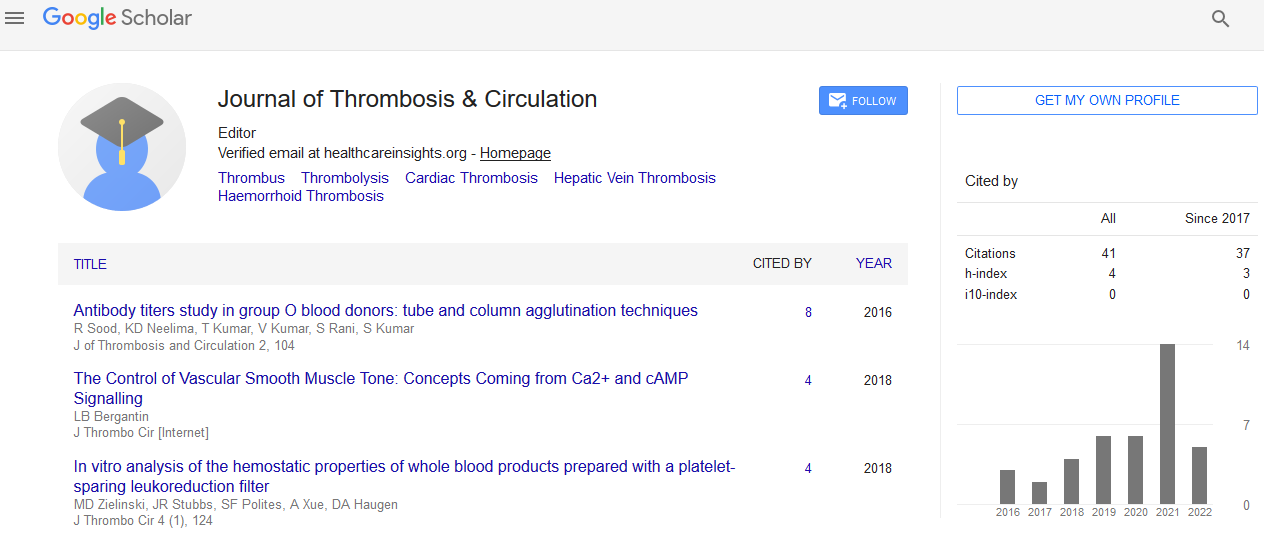Indexed In
- RefSeek
- Hamdard University
- EBSCO A-Z
- Publons
- Google Scholar
Useful Links
Share This Page
Journal Flyer

Open Access Journals
- Agri and Aquaculture
- Biochemistry
- Bioinformatics & Systems Biology
- Business & Management
- Chemistry
- Clinical Sciences
- Engineering
- Food & Nutrition
- General Science
- Genetics & Molecular Biology
- Immunology & Microbiology
- Medical Sciences
- Neuroscience & Psychology
- Nursing & Health Care
- Pharmaceutical Sciences
Editor’s Note - (2020) Volume 6, Issue 6
Editorial Note on Thrombocytopenia
Randall Alice*Received: 26-Dec-2020 Published: 30-Dec-2020, DOI: 10.35248/2572-9462.6.144
Abstract
Thrombocytopenia is a condition characterized by abnormally low levels of platelets, also known as thrombocytes, in the blood. A normal human platelet count ranges from 150,000 to 450,000 platelets per microliter of blood. Thrombocytopenia might occur as a result of a bone marrow disorder such as leukemia or an immune system problem. Or it can be a side effect of taking certain medications. It affects both children and adults. Thrombocytopenia can be mild and cause few signs or symptoms. In rare cases, the number of platelets can be so low that dangerous internal bleeding occurs. Treatment options are available.
Introduction
Thrombocytopenia emerges from three fundamental driver: incapable creation of platelets by bone marrow, sped up obliteration of platelets, or platelet splenic sequestration (Table 1). Common instances of the ineffectual creation of thrombocytes are found in the bone marrow disappointment conditions (for example aplastic pallor, myelodysplastic condition) or cycles possessing bone marrow (for example lymphoma, leukemia, different myeloma, metastases and bone marrow granulomas), while expanded obliteration is found in conditions, for example, thrombotic microangiopathies, spread intravascular coagulation (DIC) and resistant thrombocytopenia (ITP). Platelet sequestration is seen in congestive splenomegaly because of entrance hypertension that might be brought about via heart disappointment, hepatic vein apoplexy or vena cava apoplexy (BuddChiari condition), cirrhosis (for example because of constant viral hepatitis or alcoholic liver illness) and, infrequently, arteriovenous mutation of the splenic vessels. Platelet sequestration is portrayed by reallocation of platelets from those flowing to the splenic pool [4]. Various systems (expanded obliteration and diminished creation) are engaged with ITP, drug-instigated thrombocytopenia and hepatitis C infection (HCV) and human immunodeficiency infection (HIV)- actuated thrombocytopenia [5]. While assessing a patient with thrombocytopenia, it is imperative to reject pseudothrombocytopenia, an erroneously low platelet tally, brought about by in vitro agglutination of platelets happening in roughly 2% of patients with thrombocytopenia, when the blood is gathered in ethylenediaminetetra-acidic corrosive (EDTA) containing tubes. On the off chance that genuine thrombocytopenia exists, stepwise assessment is required. In clinical practice, doctors are habitually looked by a patient giving another beginning serious thrombocytopenia, the reason for which is mysterious.
The most difficult issue is to discover the reason in the briefest time and to treat the patient in like manner. Preferably, the satisfactory treatment ought to be given in regard to etiology, yet in reality, particularly if a patient presents with dying, it is unimaginable to expect to assemble all the fundamental data that would permit the clinician to gauge every one of the upsides and downsides of various medicines, since treatment ought to be given right away. In those cases, treatment that has a fast beginning of impact and is negligibly unsafe is sensible. Accordingly, the medicines given in crisis circumstances, for instance platelet bonding, ordinarily are not long haul remedial alternatives. Then again, platelet bondings may not be useful in specific etiologies, for instance in ITP, heparin-incited thrombocytopenia and thrombotic thrombocytopenic purpura (TTP). In this way, it is vital to perceive the signs and indications of these elements. In this survey we endeavor to give a calculation through which the cause(s) of thrombocytopenia can be evaluated.

